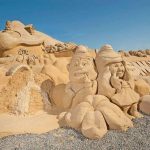What about siwa oasis?
We’re going to know more information about siwa oasis in detail through this blog post from FTS press.
The definition of beauty is “in the eyes of the beholder.” This assertion by Oscar Wilde is entirely applicable to making the journey: it is not only crucial to select the right place. What you anticipate and are prepared to accomplish in this place is equally important. If your heart is open to discovering the world and your eyes are open to supernatural events, you will undoubtedly receive them! Egypt has several secrets; one of the people is the siwa oasis, which I’ll tell you about now.
siwa oasis
Relocating from the White Desert to siwa oasis was exhausting and tedious: for nearly six hours, we decided to move in a straight line, like such a taut string, along an ancient route, trying to pass thirty kilometers.
Such nearness left an imprint on the entire 400 kilometers of the road: every 15-20 minutes, one had to stop at the border cordons. Tanks, anti-aircraft guns, sentries – automatic weapons at the ready, albeit with hollowed-out butts replayed with office tape. The private parts were fully camouflaged – with bulletproof vests and helmets – while the officers ran out to check our files in trainers with outreached knees, slates on bare feet, T-shirts, and an immutable cigarette in their teeth. But this unrepresentative presence did not deter them from trying to turn the components of our luggage inverted with an unfazed look in seek of, likely, smuggled firearms; instances allured their special attention with tripods.
What exactly is a fantastic journey?
A nasty, methodically repetitive sound began to be heard at some point in the car I was traveling – a fuel-sensing element signaled this. Nevertheless, the driver of our Jeep disregarded him. But only until the car ultimately decided to stand up on its own. I took time to transfer energy from one car to another. Soon after, we see an armored convoy charging toward each other on all fours. It started to turn out that a guard was sent from the cordon, of the kind that we hadn’t yet managed to reach and had did miss the regulated time we had arrived on, to find out where we’d gone.
Siwa is a wilderness oasis dedicated to Amun
Siwa Oasis is an existence island lost in the Awesome Desert, the farthest from the Nile Valley and Delta and the most secluded of Egypt’s oases. It is sited in the west of the country, 50 kilometres from the Libyan border, in the Qattara Depression, whose elevation is below sea level. Siwa, like with any oasis, owes its existence to water: subsoil waters from the eastern Sahara, or Libyan desert, break into the surface with multiple sources, including cold spring water that can be consumed and water management, as well as warm and silicate minerals water.
It’s no random occurrence that Siwa’s ancient Egyptian title is Nekht-am, which also means “Land of Palms”: date palms of varying kinds are the oasis’s main wealth and the foundation for its inhabitants’ prosperity. However, the palm is more than just the fruit for the Siamese. Its leaf falls to the roof and guardrail, and its trunks – whole or sawn in length – fall to the floors of buildings. Palm wood is tough and long-lasting. Even chairs are created of it – it offers a free, light look but is unusually heavy: I couldn’t keep moving such a chair, which I came across among the remains of an ancient city.
Olive trees, which thrive in the oasis, are another source of income and pride for the Sivan’s. Canned, salted, pickled olives… On the advice of knowledgeable friends, I couldn’t help but bring home a few bottles of olive oil that also turned out to be very spicy! As well as a bag of dates purchased in the same store dispersed with cosmic speed: the daughter claimed that she had never tasted any of it tastier than this date and time.
Surprisingly, almost none of the Siwa residents were ashamed or upset when they observed the lens of my camera respond by pointing at them. Conversely, adults proceeded to conduct their usual tasks tirelessly, and pleasant children lined up in rows.
Life is bustling in the oasis’s “business center”: there is a market brimming with domestic and export vegetables and fruits, an open-air bakery, stores, and “eateries,” and everyone is preoccupied with their own business. In the shade on the cafe’s veranda, as in the theatre stalls, and taking a sip graciously flavored with fresh mint sugary sweet tea, you could happily observe the action on the “stage” – the leisurely and evaluated life of the Sivan’s. Time appears to have stopped here:
- They drink water from glass cups no bigger than a thimble.
- Perform backgammon, and goats walk freely thru the streets with no noticeable oversight.
- Many kids are playing.
What helps make Siwa Oasis unique?
Siwa Oasis appears out of nowhere, its lush, green gardens shimmering like a mirage in the surrounding barren, uninhabitable wilderness. And over 300 freshwater springs, as well as streams, feed 300,000 date palms as well as 70,000 olive trees in this barren desert oasis. Massive saltwater lakes add to the breathtaking scenery.
How large is Sudan’s Siwa oasis?
The oasis is six miles (10 km) long and 4-5 miles (6-8 km) wide, with approximately 200 springs. The old walled settlers of Siwa and Arm, which are natural fortifications, are located on two mossy rocks. Berber-speaking Sudanic peoples live in slum areas at the leg of their former strongholds in the oasis.
Siwa Oasis is located in Egypt
Siwa Oasis is an oasis in the governorate of Maar Mufaah in western Egypt. It is located near the Libyan border, 350 miles (560 kilometers) west-southwest of Cairo. The oasis is 6 miles (10 km) long and 4-5 miles (6-8 km) wide, with approximately 200 springs. The old walled settlements were located on two rock outcrops.
What is the Siwan Oasis well-known for?
Siwa Oasis has a range of activities, places to visit, and exotic. She is a popular tourist attraction where visitors can climb a melted pile of mud and salt that was once a common Siwan construction material in the 1300s.
What draws people to Siwa Oasis?
Throughout history, Siwa has been a popular stop for travelers and nomads. It supplied them with a plentiful supply of drinking water, food, and shelter. As per historical records, humans have been here since the 29th century BC. This oasis is best known for growing a variety of dates and times and olives.
Is there life in Siwa Oasis?
The primary Oasis lakes, Birket al-Maraqi and Birket Siwa are salty and have no marine life. A portion of the water is so saline that crystals can be observed growing in it. The saltwater soil of the oasis is still being used to construct traditional mudbrick houses, causing issues.
Is it worthwhile to visit Siwa Oasis?
Siwa is an enjoyable oasis of lagoons and palm trees in the wilderness, just 50 kilometers from the Libyan border (but don’t panic, it’s completely safe). It’s a perfect way to relax and unwind after the rush and bustle of Luxor and the filthy sprawl of Cairo.
Is it possible to swim in Siwa Oasis?
Swim in a freshwater source at Cleopatra spring in Siwa. Snorkeling is also feasible across several lakes and water sources around the Siwa, though some necessitate the recruitment of a jeep/guide.
Could indeed you swim in the salt pools at Siwa Oasis?
Siwa covers 33 sq miles and is encircled by sands and sandstone mountain ranges. The antiquity oasis, once got to visit by Alexander the Great, is rich in cultural and archaeological sites, but most tourists prefer to swim.
Is the water at Siwa Oasis pure?
The Siwa Oasis provides a substantial fraction of Egypt’s freshwater supply. It is situated in Egypt’s thinly populated far western region, only 30 miles from the Libyan border.
What is the depth of the pools in the Siwa Oasis?
These salt lakes are known as Al-Tibtah and are positioned at the foot of the Siwa mountain. Zeitoun Lake contains hundreds of salt deposits or salt reservoirs.
Where does water at Siwa Oasis come from?
In Siwa Oasis, aquifers are the only origin of irrigation and drinking water (Bliss, 1999). The conventional reference of irrigation in Siwa Oasis is old artesian wells originating from the top shallow groundwater flow; there are 220 of these wells.
Is there any fish in Siwa Oasis?
These ponds are so salty that no marine life can stay alive, and fishery is not a ritual in the oasis.
Is it feasible to live in an oasis?
Folks who reside in an oasis must carefully control their water and land utilize. The date palm (Phoenix dactylifera L.), which also shapes the top part of an oasis, is the most important medicinal plant.








